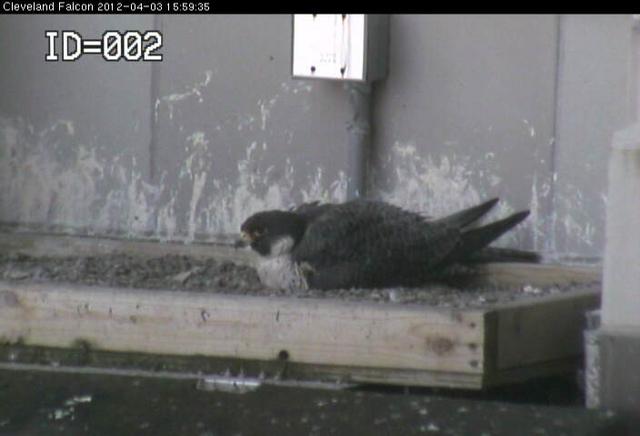FALCON FLASH......
Dateline: Cleveland, Ohio
April 4, 2012
SW and Boomer are keeping their precious eggs covered to stay warm and dry. Incubation usually lasts 33 to 35 days from the date the last egg, or the second last, was laid. If you have been watching the FalconCam lately, you have seen a lot of pictures that look like this.
While SW spends most of her time on the eggs, Boomer spends a lot of time hunting. You probably know by now that peregrine falcons are predators and their major prey is other birds. Why do they like cities so much? Lots of birds!
In a man-made environment, the numbers within species may get out of balance. Cities sometimes have too many pigeons, which can cause a mess and can even cause disease. Some cities and building owners try to limit the number of pigeons. Before the peregrines moved in, the owners of SW and Boomer’s skyscraper installed a system of loudspeakers, wiring and brackets as a “pigeon repellant system”. The idea was that if loud noises were playing, the pigeons would go away. It didn’t work. A longtime falcon fan tells us, " Today, no methods of pigeon control are in use. Staff from Terminal Tower building maintenance says the falcons do an excellent job of keeping the pigeons away from the building, which is one reason building management is supportive of the continued presence of the Peregrine Falcon nest site." At least the old speakers were good for something - for years, the falcons used them as convenient perches and launching pads.
In Connecticut, taxpayers thank a peregrine falcon couple that nest on a bridge. Until the birds decided to make their home on this bridge, too many pigeons were present and caused a big mess. Why? Feces! (look it up if you don't know the word). The Connecticut Department of Transportation used to have to spend thousands of dollars every year to clean off the bird feces to keep the bridge safe for cars, but when peregrine falcons moved in, most of the pigeons disappeared, and no more mess to clean up. Other states use this natural pigeon-control method by building nestboxes for peregrines on bridges or wherever too many pigeons cause problems.
Volunteers Mr. and Mrs. Saladin often watch the falcons hunt pigeons and send along pictures they have taken. Back in winter before eggs were laid, Mr. and Mrs Saladin observed courtship hunting for pigeons: “We watched the pair hunt together ……. They perched up on the Bank ledge near the top as the pigeons accumulated on the window sills below them. SW repeatedly dove down against the building toward them……..
and as the pigeons flushed her mate would join in and chase them out over the square. ……. some of the pigeons were a bit slow leaving the window ledges and SW nearly snagged one……… it created a frenzy, as some of the pigeons just about flew into one another trying to escape”. According to the Canadian Peregrine Foundation, the average peregrine is successful in catching its prey only 2-4 times in 10 attempts.
That day, even with two raptors hunting together, they did not catch a pigeon while Mr. and Mrs. Saladin were watching. How do pigeons escape the fastest creatures on earth? Pigeons have several characteristics that help them. To learn why pigeons are often successful in escaping the falcons, go to: http://videos.howstuffworks.com/animal-planet/28406-fooled-by-nature-pigeons-vs-the-peregrine-falcon-video.htm
According to the Canadian Peregrine Foundation, “A study conducted at Cornell University demonstrated that females are more efficient hunters, because they can catch larger prey species, and therefore need to make fewer hunting expeditions, and as a result conserve energy”. Mr. and Mrs. Saladin returned another day and saw SW successfully catch a pigeon using a different hunting style, “Here she used her dive down technique from the TT building ledge across from the nest tray. She dove off, but just glided low over the square and came right up on the pigeon from behind and snagged it. We don't think the pigeon ever saw her, as it didn't make any attempt to evade her (or maybe the pigeon didn't realize that she wasn't another pigeon until it was too late)”.
For now, Boomer is doing most of the hunting and feeding SW. This will continue until the chicks are old enough for SW to leave them. Then it will take two parents hunting to feed the growing family.
Question: The peregrine falcon is the state raptor of what state? Hint: It appears on this state’s quarter.
To watch the falcons live go to: http://www.falconcam-cmnh.org/news.php
Our thanks to the Cleveland Museum of Natural History for sponsoring the FalconCams and for the still.
Photos of SW launching off the old speaker and the last picture of talons are courtesy of Scott Wright. Pigeon hunting pictures are courtesy of Mr. and Mrs. Saladin. They may be used by children for school and/or personal projects, but please give photo credit.
Click here to read what happpened earlier.
Click here to read what happpened next.





